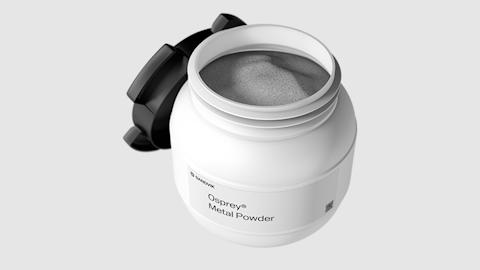Osprey® 1.4882
Request a quoteAustenitic stainless steel
Osprey® 1.4882
Osprey® 1.4882 is an austenitic chromium-manganese stainless steel with good resistance to corrosion, oxidation and creep at high temperature.

- UNS
- S63019
- ASTM, AISI
- XEV-F
- EN Name
- X50CrMnNiNbN21.9
- EN Number
- 1.4882
Powder designed for
- Metal Injection Moulding (MIM)

This metal powder is manufactured by Inert Gas Atomization (IGA), producing a powder with a spherical morphology which provides good flow characteristics and high packing density.
-
Product description
Osprey® 1.4882 is an austenitic chromium-manganese stainless steel. The alloy is typically used in automotive applications where good resistance to corrosion, oxidation and creep at high temperature is required.
This metal powder is manufactured by Inert Gas Atomization (IGA), producing a powder with a spherical morphology which provides good flow characteristics and high packing density. In addition, the powder has a low oxygen content and low impurity levels, resulting in a metallurgically clean product with enhanced mechanical performance.
Product description
Osprey® 1.4882 is an austenitic chromium-manganese stainless steel. The alloy is typically used in automotive applications where good resistance to corrosion, oxidation and creep at high temperature is required.
This metal powder is manufactured by Inert Gas Atomization (IGA), producing a powder with a spherical morphology which provides good flow characteristics and high packing density. In addition, the powder has a low oxygen content and low impurity levels, resulting in a metallurgically clean product with enhanced mechanical performance.
Osprey® 1.4882 is an austenitic chromium-manganese stainless steel. The alloy is typically used in automotive applications where good resistance to corrosion, oxidation and creep at high temperature is required.
This metal powder is manufactured by Inert Gas Atomization (IGA), producing a powder with a spherical morphology which provides good flow characteristics and high packing density. In addition, the powder has a low oxygen content and low impurity levels, resulting in a metallurgically clean product with enhanced mechanical performance.
Technical data
Page updated Sep 8, 2023 9:50 AM CET (supersedes all previous editions)
Downloads
-
Chemical composition (nominal), %
- Fe
- Bal.
- C
- 0.5
- Cr
- 21
- Ni
- 4.5
- Si
- 0.3
- Mn
- 9.0
- S
- ≤0.05
- P
- ≤0.03
-
Powder characteristics and morphology
Powder for Metal Injection Moulding (MIM)
Osprey® MIM powder has a spherical morphology, resulting in high packing density. This enables the manufacture of feedstocks with high powder loading, which not only minimizes binder costs but also reduces part shrinkage during debinding and sintering. Spherical powder also has excellent flow characteristics, resulting in reduced tool wear and consistent mould filling.
Osprey® MIM powder's low oxygen content allows better control of carbon and consistency during sintering. Low oxygen levels, together with high packing density, also facilitate faster sintering.
-
Particle size distribution
Powder for Metal Injection Moulding (MIM)
Osprey® metal powder for Metal Injection Moulding (MIM) is available in a wide range of particle size distributions, from under 5 μm up to 38 μm. The table shows our standard particle size distributions for MIM powders.
Typical particle size distributions for Metal Injection Moulding (MIM)* Size (μm) D10 (μm) D50 (μm) D90 (μm) ≤ 38 5.5 13.0 31.0 ≤ 32 5.0 12.0 29.0 80% ≤ 22 4.5 11.5 27.0 90% ≤ 22 4.0 10.5 22.0 90% ≤ 16 3.5 8.0 16.0 *Particle size measurements performed using a Malvern laser particle size analyzer, typical D10, D50 and D90 provided.
Tailor-made particle size distributions are available on request. Contact us to discuss your specific requirements.
-
Testing
All Osprey® metal powders are supplied with a certificate of analysis containing information on the chemical composition and particle size distribution. Information on other powder characteristics is available upon request.
-
Packaging
A wide range of packaging options are available, from 1 kg (2.2 lb) to 200 kg (440 lb)*.
Contact our team who can support you with selecting the right packaging for your product and application.
*Some packaging options may not be available for all products due to international shipping regulations.
Disclaimer: Data and recommendations are for guidance only, and the suitability of a powder for a specific process or application can be confirmed only when we know the actual conditions. Continuous development may necessitate changes in technical data without notice. This datasheet is only valid for Osprey® powder.
Range of austenitic stainless steel
| Osprey® | Standards* | Fe | C | Cr | Ni | Mo | Si | Mn | S | P | Other | O | |
|---|---|---|---|---|---|---|---|---|---|---|---|---|---|
| 1.4882 | UNS S63019 | Bal. | 0.5 | 21 | 4.5 | - | 0.3 | 9.0 | ≤0.05 | ≤0.03 | - | - | |
| 304L | UNS S30400 / S30403 | Bal. | 0.03 | 18.0-20.0 | 8.0-12.0 | - | 1.0 | 2.0 | 0.03 | 0.045 | - | - |
304L
|
| 310S | UNS S31008 | Bal. | 0.08 | 24.0-26.0 | 19.0-22.0 | - | 1.5 | 2.0 | 0.03 | 0.045 | - | - |
310S
|
| 316L | UNS S31600 / S31603 | Bal. | ≤0.03 | 16.0-18.0 | 10.0-14.0 | 2.0-3.0 | ≤1.0 | ≤2.0 | ≤0.03 | ≤0.045 | N ≤0.10 | - |
316L
|
| 316Ti | UNS S31635 | Bal. | 0.08 | 16.0-18.0 | 10.0-14.0 | 2.0-3.0 | 1.0 | 2.0 | - | - | Ti 0.7,N 0.25 | - |
316Ti
|
| 904L | UNS N08904 | Bal. | 0.02 | 19.0-23.0 | 23.0-28.0 | 4.0-5.0 | 1.0 | 2.0 | 0.035 | 0.045 | - | - |
904L
|
| HK30 | JIS J92403 | Bal. | 0.25-0.35 | 23.0-27.0 | 19.0-22.0 | 0.5 | 0.75-1.75 | 1.5 | - | - | Nb 1.20-1.50 | - |
HK30
|
| N-50 | UNS S20910 | Bal. | 0.03-0.05 | 20.5-22.0 | 11.7-13.0 | 2.0-2.5 | 0.2-0.6 | 4.0-5.5 | ≤0.015 | ≤0.040 | Ta ≤0.10, Ti ≤0.02, Sn ≤0.03, W ≤0.15, Cu ≤0.75 | - |
N-50
|
| N-60 | UNS S21800 | Bal. | 0.1 | 16.0-18.0 | 8.0-9.0 | - | 3.5-4.5 | 7.0-9.0 | - | - | N 0.08-0.18 | - |
N-60
|
| PANACEA | - | Bal. | ≤0.05 | 16.5-17.5 | ≤0.10 | 3.0-3.5 | 0.40-0.80 | 10.5-11.5 | ≤0.04 | ≤0.04 | Co ≤0.05, N 0.15-0.60, Nb ≤0.73 | <0.2 |
PANACEA
|
* Information about more standards is available in the datasheet for the respective alloy.
Get in touch with our experts in metal powder today
